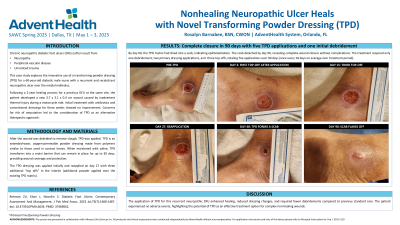Practice Innovations
(PI-002) Nonhealing Neuropathic Ulcer Heals with Novel Transforming Powder Dressing

Chronic neuropathic diabetic foot ulcers (DFUs) often result from neuropathy, peripheral vascular disease, and unnoticed trauma. This case study explores the innovative use of a Transforming Powder Dressing (TPD) for a 60-year-old diabetic male nurse with a recurrent neuropathic ulcer over the medial malleolus. Following a 2-year healing process for a previous DFU at the same site, the patient developed a new 3.7 x 3.1 x 0.4 cm wound caused by inadvertent thermal injury during a motorcycle ride. Initial treatment with antibiotics and conventional dressings for three weeks showed no improvement. Concerns for risk of amputation led to the consideration of TPD as an alternative therapeutic approach.
Methods:
After debridement to remove slough, TPD was applied to the wound. TPD is an extended-wear dressing comprising of polymers that transform into a moist, oxygen-permeable matrix when hydrated, providing a protective environment for wound healing. The dressing was applied initially, with a reapplication on day 27 and 3 additional "top-offs."
Results:
By day 60, the TPD matrix had dried into a scab, indicating epithelialization. The scab detached by day 90, revealing complete wound closure without complications. The treatment required only one debridement, two primary dressings, and five total applications of TPD over 90 days (once every 18 days on average).
Discussion:
The application of TPD for this recurrent neuropathic DFU demonstrated a faster healing rate, reduced dressing changes, and fewer debridements compared to previous standard care. The patient experienced no adverse events, highlighting the potential of TPD as an effective treatment option for complex wounds.

.jpg)